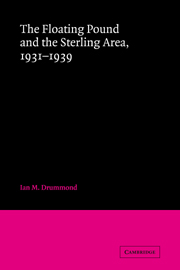Book contents
- Frontmatter
- Contents
- Preface
- 1 Introduction: the sterling area in the 1930s
- 2 Sterling and the rupee
- 3 The Canadian debate over money and exchanges, 1930–1934
- 4 South Africa, sterling, and the gold standard, 1931 and thereafter
- 5 Australia and New Zealand, 1930–1939
- 6 Monetary preparations for the World Economic Conference
- 7 United Kingdom policy at the World Monetary and Economic Conference
- 8 Talking about exchange stabilization, autumn 1933 through June 1936
- 9 The Tripartite Agreement of 1936
- 10 Intergovernmental conversations and the management of sterling, 1936–1939
- 11 Conclusion: the significance of sterling
- Notes
- Index
8 - Talking about exchange stabilization, autumn 1933 through June 1936
Published online by Cambridge University Press: 07 October 2011
- Frontmatter
- Contents
- Preface
- 1 Introduction: the sterling area in the 1930s
- 2 Sterling and the rupee
- 3 The Canadian debate over money and exchanges, 1930–1934
- 4 South Africa, sterling, and the gold standard, 1931 and thereafter
- 5 Australia and New Zealand, 1930–1939
- 6 Monetary preparations for the World Economic Conference
- 7 United Kingdom policy at the World Monetary and Economic Conference
- 8 Talking about exchange stabilization, autumn 1933 through June 1936
- 9 The Tripartite Agreement of 1936
- 10 Intergovernmental conversations and the management of sterling, 1936–1939
- 11 Conclusion: the significance of sterling
- Notes
- Index
Summary
After the World Economic Conference had collapsed, the question of exchange stabilization did not stay dead. Professor Sayers has explained that Governor Harrison of the New York Federal Reserve Bank pressed for some Anglo-American agreement in summer 1933 and then again in November. Unable to buy gold freely with dollars, the Exchange Equalisation Account operated chiefly in French francs, and from time to time it was able to peg the sterling-franc rate. Between the Bank of England and the Bank of France, understanding and cooperation steadily increased. But the French continued to press for some more formal arrangement, and after the United States had returned the dollar to gold American pressure was not unknown. Though it was interested in the management of sterling, and increasingly willing to envisage some sort of international cooperation in exchange management, the Treasury consistently resisted this pressure. The chancellor of the exchequer was if anything even more determined than his officials. The principal purpose of this chapter is to chronicle the Franco-American initiatives and Whitehall's responses.
Franco-American importunities
In the Treasury, the Bank, and the mind of the chancellor, the events of spring and summer 1933 had left a definite deposit of suspicion. As we have seen, Chamberlain was already inclined to distrust the Americans, and, in particular, the president. “Master Roosevelt,” as Chamberlain called him, would tack and change course in response to every political breeze.
- Type
- Chapter
- Information
- The Floating Pound and the Sterling Area1931–1939, pp. 181 - 200Publisher: Cambridge University PressPrint publication year: 1981



